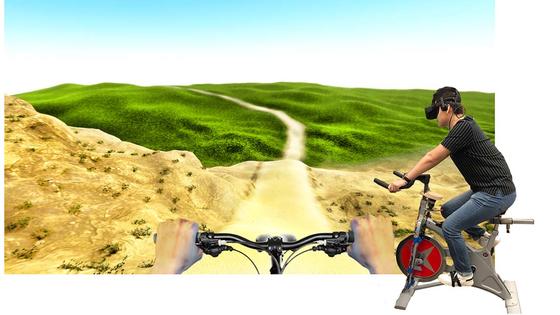For many, exercise is a laborious chore, better put off until tomorrow. But Craig Yu, an associate professor in George Mason University's Department of Computer Science is hoping a combination of virtual reality and gamification will make exercise an appealing—and even fun—endeavor.
Virtual reality (VR) is becoming ubiquitous, popping up in everything from serious activities like military applications and surgery support to recreational activities like theme park attractions and at-home video games. Yu and colleagues are seeking to use the immersive VR world to help make exercise appealing. And more than that, they want to tailor your exercise routine to your fitness needs and abilities, in real time.

Imagine strapping on a VR headset and hopping on a stationary bike. You input goals such as calorie burn, heart rate changes, and other exertion targets. You then choose the terrain you want—maybe it’s a rocky hill or a desert scene and maybe a hazard or particular landmark is added for aesthetics. The game will then suggest path length and difficulty, among other things, to help you meet those goals.
After you set off and your exercise output changes and fluctuates, the path will adjust in real time so that you ultimately get the precise workout you are seeking. Along the way, elements of gamification like point scoring, goal achievement, and collecting bonuses work to incentivize you.
To develop this technology, the researchers hacked a gym bicycle with a step motor, which controls the bike’s resistance according to the elevation of the VR terrain. If the user goes uphill, the bike's resistance will increase accordingly such that the user has to push to climb the hill, resulting in haptic realism and also the desired exertion effects.
Yu, who directs the Augmented and Virtual Reality Lab in Fuse at Mason Square, will be demonstrating "exertion path generator" technology at the Grand Celebration of Fuse on September 25.
Yu has a grant from the National Science Foundation’s (NSF) I-Corps program to further develop the technology. I-Corps “prepares scientists and engineers to extend their focus beyond the laboratory to increase the economic and societal impact of NSF-funded projects.” It helps academics think about commercializing their product via market research, iterative product development, and other common elements of bringing a product to market. While what they built was a prototype, the team is learning how to develop their creation to appeal to gym equipment companies, such as Peloton for example.
The I-Corps program is extensive, Yu says. “We have one month where we meet with NSF coaches and members of other teams. We learn different aspects of commercialization and customer discovery.” Among other things, participants must interview at least 100 potential customers about their product, helping to determine if a market actually exists for the device and, if so, if the product meets customer needs in its present form.
Yu says they talked to people from defense contractors, government agencies, and schools, among other places, with positive feedback, mostly around the practical challenges of using and getting used to VR experiences.
Yu is optimistic about the future of VR, noting that an extensive gaming culture among incoming college students leads many to want to explore research in the field. He recalls his own interest. “I was a junior faculty when Oculus Quest (an early VR headset) came out. It really amazed me! It was very cheap and we could do a lot of research projects based on it, including developing training and education programs.”
Yu says those practical uses are just now being fully explored. “On one hand, you need to make training really effective, not just fun. It should teach people something essential for their job. If someone performs very well in VR training, does it mean the person can perform equally well in the workplace? So there's a gap here and this is exactly what researchers are looking at, like whether people can transfer the knowledge effectively.”
But in the meantime, strap on the VR headset, pull up a course ending on the Champs-Élysées and pretend you’re wearing the yellow jersey as you hit that calorie goal. Fortunately, the croissants waiting for you at your ride’s end are only virtual.
Thumbnail art created by Simon Waldherr under CC BY-SA 4.0.
In This Story
Related News
- October 22, 2025
- October 20, 2025
- September 19, 2025
- August 20, 2025
- August 15, 2025
